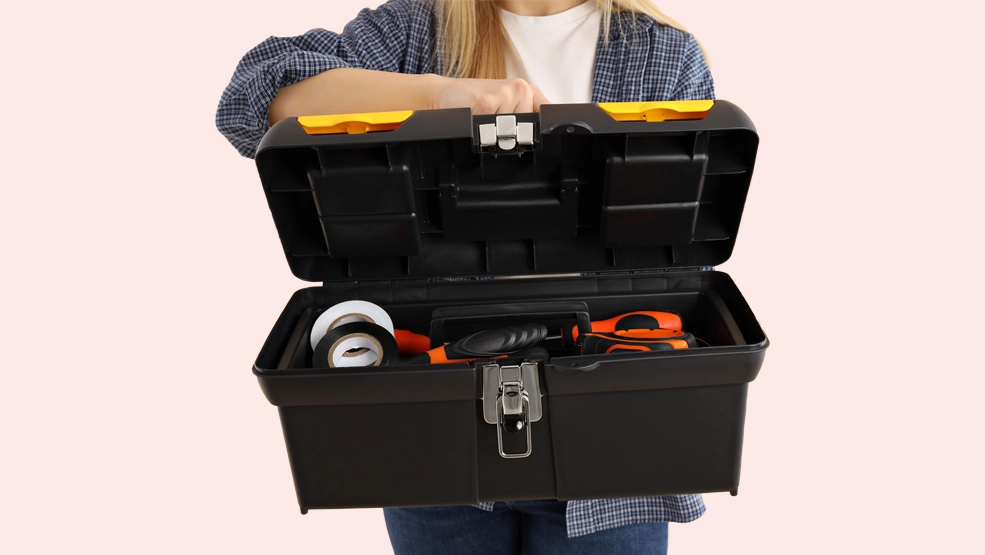Hand tools have been a part of the world since prehistoric times. The transition from Stoneage wedges to modern engineering tools has changed how works are performed today.
Wheater you’re an experienced handyman looking to build your business or a DIY enthusiast trying to do your own repairs, having a list of the most important tools for completing a variety of jobs is something that will come in handy.
A handyman tackles a range of repairs, from minor inconveniences like fixing leaky faucets to much more significant repairs, such as painting and electrical work. A well-stocked tool kit is critical for success; without the right tool, you may have to turn down a job or make a return trip to the site. Avoid wasting time and losing out on making money—ensure you have the right tools in your kit.
In this article, we’ll examine the list of essentials tool every handyman should own. Before jumping in, let’s look at some tips for choosing the right tools.
Tips for choosing the right tools
Choosing the proper hand tools can be tricky, but with the right tips, you’ll be able to select the perfect tools to meet your needs.
Here are some tips to keep in mind while picking your hand tools
Identify your needs. Before spending thousands on hand tools, it is necessary to identify and understand why you need them. Before going out to buy hand tools, you should know what you’ll be using them for. Choosing the appropriate tools for a task keeps you from spending thousands of dollars on tools you may never use. Invest in the tools that are most essential to the work that you will actually be doing, and you can upgrade and branch out as necessary later on.
Learn the ergonomics of tools. When choosing tools, it’s essential to learn their ergonomics. Understanding the ergonomics of a tool helps you optimize its performance by making sure you don’t handle the tool in inappropriate ways. Additionally, using tools with good ergonomics helps to prevent injuries.
Beware of its limitations. Every hand tool has its own limitation. It is essential to be aware of what these limitations are and how they will impact your ability to complete jobs quickly and efficiently. By knowing the limitations of each tool and what tools can be used for more than one job, you will be able to buy only the tools that make the most sense for you, allowing you to minimize the tools you need to carry and maximize the number of jobs you are able to perform.
13 Tools Every Handyman Should Own
Now that you know what to look for when buying tools, We’ll take a closer look at what tools every handyman should own
1. Claw hammer
No toolbag is complete without a claw hammer. Regardless of whether it is the toolbox of a DIY enthusiast or a professional repairman, a claw hammer is never out of place; it is an essential tool that all tool kits should have. A claw hammer can be used to perform a wide range of jobs, from hammering and removing nails to minor demolition.
A quality hammer will last you a lifetime. When buying a claw hammer, choose a medium-weight hammer with a comfortable rubber handle to prevent slipping (avoid wooden handles as they can easily break). Remember to choose a hammer that feels comfortable and balanced in your hand.
2. Tape measure
Another essential drive of every toolbox is a tape measure. The ability to measure things is necessary for almost every project, be it a DIY home repair or something more professional. When choosing a tape measure, it’s best to go for one that’s around 8m in length, as this will be long enough to measure most rooms.
Make sure that the tape measure has numbers and markings that are easy to read and is durable enough to survive being dropped or stepped on.
3. Screwdriver set
A screwdriver set is a necessary tool in every handyman’s toolbox. If you’ve ever tried putting flat-packed furniture together, tightening a loose screw, or even opening a paint tin, then you’ll know that a screwdriver is a necessary part of any handyman’s toolkit. Screwdrivers come in different shapes and sizes, and each is used for different purposes.
Rather than purchasing a variety of screwdrivers, however, you can instead look into buying a screwdriver with interchangeable heads. The advantage of this is increasing your flexibility to perform a variety of jobs, but only needing to carry a single handle and any bits that you might need. While there are more pieces to keep track of, the space required in your tool kit is reduced, which means there is more space for something else.
4. Power drill
A cordless drill could probably be the most expensive tool. A power drill can be used to make quick work of most home improvement and DIY projects. It will also likely be a frequently used tool, so it is necessary to invest in a high-quality product.
Cheap cordless drills will lose power quickly and require longer recharge times, so look for a drill with a minimum rating of 12v and make sure you have two high-quality batteries.
5. Putty knife
The majority of manual laborers have a few putty knives in their kit. While some people choose to buy their knives separately, others get a set of five putty knives that range in length from two inches to one foot.
Putty knives serve a wide of functions, some include:
- Applying and smoothing spackle,
- Spreading compound along joints between drywall sheets,
- Preparing interior and exterior surfaces for painting by scraping loose paint,
- Reglazing windows,
- Filling nail holes,
- Removing wallpaper from tight spots (such as door casings)
6. Spirit Level
Another home DIY essential is a spirit level. Whether you’re hanging a picture or building a house, you will require a spirit level to determine the true horizontal. The size of the spirit level depends on the nature of the jobs you undertake.
For smaller projects such as hanging frames and shelves, a 30cm spirit level will be adequate. However, if your plans involve hanging doors and installing windows, consider investing in a 60cm spirit level.
7. Pliers
One of the tools that every handyman should have is a pair of pliers. Having multiple types of pliers will allow you more flexibility with the types of projects that you can tackle. Ensure you have needle nose pliers for wires as well as tongue and groove pliers for pipes.
Having pliers helps you get a handle on a range of home improvement projects. Made from steel, pliers are available in a variety of types, some adjustable and some non-adjustable. Each type is designed for a different purpose, so make sure to include the pliers in your kit that are most relevant to the types of projects you are likely to encounter most frequently.
Below are a few uses of the pilers sets
- Long pliers: grips small objects and twist wires
- Needle nose pliers: reaches into tight spots
- Slip-joint pliers: adjusts nuts and bolts
- Tongue-and-groove pliers: tightens plumbing pipes
- Insulation-stripping pliers; wire cutters and splicers
- Adjustable wrench: turns nuts and bolts
8. Adjustable wrench / Spanner
An adjustable spanner is similar to an open-end wrench with a moveable jaw allowing it to be used on different types of fastener heads. Having an adjustable wrench is like an entire wrench kit in one tool; keeping an adjustable wrench in your toolbox allows you to address a broad range of projects and is definitely the right move if you tend to focus on plumbing or mechanical projects.
9. Stud finder
A stud finder allows you to find the studs. A stud finder is an essential tool when mounting heavy items, like picture frames, on walls. Don’t let that brand-new flat-screen TV or 100-pound antique mirror end up on the floor!
Stud finders come in three different types: magnetic, electronic, and radar-powered.
- Magnetic stud finders locate studs by detecting the presence of nails and screws within the studs, much like magnets attracting metal.
- Electronic stud finders utilize sensors that detect variations as they pass over a stud.
- Radar-powered stud finders employ electromagnetic waves to locate studs. However, they have the additional capability to detect wires, leaks, plumbing, and even motion caused by pests within the walls.
10. Safety tools (gloves, goggles, earplugs)
If you’re a handyman or a DIY enthusiast, you will end up using your hands a lot. So make sure you protect them with a pair of durable gloves. A nice pair of leather or latex gloves can provide the protection you need without losing grip strength.
You need the dexterity to complete work quickly; a good pair of gloves will help you maintain excellent grip strength while also protecting you on the job.
To safeguard your eyes from debris such as dust, wood, or metal shavings, it is recommended to wear safety goggles. These goggles are widely available, affordable, and offer excellent protection. Look for a pair that fits you well. By wearing this protective gear, you can prevent eye injuries caused by hazardous chemicals, intense light, and other materials.
Certain home projects involve the use of loud tools. Before you tackle these tasks, it is essential for you to protect your eardrum by inserting earplugs — they’re more sensitive than you might think!
If you’re exposed to sounds 85 decibels or more for extended amounts of time, this can induce loss of hearing.
11. Adhesives
Both DIYers and home improvement professionals find themselves needing to bond two objects together, and when they do, there is any number of adhesives to turn to.
Not only will these adhesives be useful for big DIY projects, but they will also be useful for minor home repairs:
- Electric tape
- Duct tape
- Masking tape
- Wood glue
- Superglue
Make sure these essentials are part of your handyman tools!
12. Fasteners
Every handyman should be prepared with the right tools. Along with your toolset, having a readily available assortment of nuts, bolts, and screws can make any project or household emergency much more manageable.
No handyman’s toolbox would be complete without a potpourri of screws, nuts, bolts, and anchors overflowing coffee cans and worn cardboard boxes.
Consider dedicating a section of your toolbox to all kinds of fasteners. Make sure to add the unused ones from your previous projects Some of the more common fasteners include:
- Screws
- Nuts
- Bolts
- Washers
- D-rings
- Exterior wood screws
- Zip ties
13. LED flashlight or headlamp
Want professional-looking results with every project? Include an LED flashlight and a headlamp in your arsenal tools list. A light source is particularly useful when working in dark areas like the basement or under the stairs, and you will be glad to have one on hand..
Conclusion
No one likes dealing with emergency repairs, but if you have the right tools, even an unexpected repair can seem less daunting. Plan your toolbox carefully with the right selection of tools, and you won’t have to worry about not being able to handle the basics. Carrying the right tools helps a handyman tackle problems from minor repairs to full-scale breakdowns—and to do it quickly and efficiently, helping to avoid the cost of unnecessary downtime. Every minor repair to significant breakdowns and avoid the cost of unnecessary downtime.










